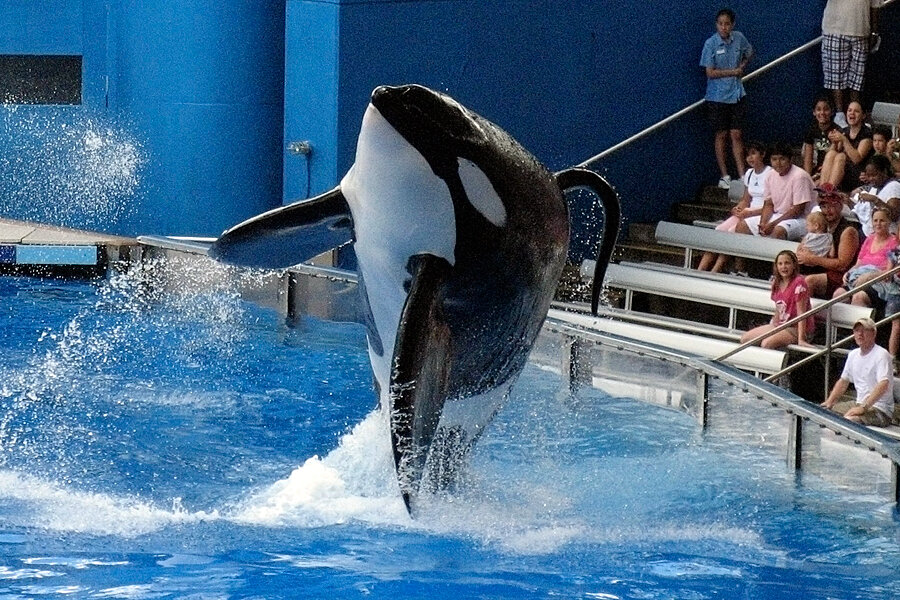SeaWorld killer whale: Should trainers swim with orcas? Appeals court to rule.
Loading...
Marine mammal park company SeaWorld, whose trainers were barred from close contact with killer whales after an orca named Tilikum killed a trainer in 2010, is arguing in federal appeals court that government regulators overstepped their authority when they restricted that contact.
Following this year's release of the documentary "Blackfish," which alleges that SeaWorld has withheld information on accidents and fatalities involving killer whales, the entertainment company's practices have come under heightened scrutiny.
The U.S. Court of Appeals for the D.C. Circuit is now being asked to decide if requiring barriers and minimum distances between orca and human performers is a sensible safety measure imposed by the Occupational Safety and Health Administration (OSHA), or a crippling curtailment of Orlando-based SeaWorld's main attraction.
"It's as if the federal government came in and told the NFL that 'close contact' on the football field would have to end," SeaWorld's attorney, Eugene Scalia, told the three presiding judges, arguing that playing pro football incurred more injuries than training orcas.
Chief Judge Merrick Garland questioned that logic, asking if the restriction on SeaWorld weren't more akin to requiring helmets in football games. Did the helmet "totally change the nature of the presentation of the NFL?" Judge Garland asked.
In court documents filed Wednesday, SeaWorld argued that the contact in orca shows, in which the striking animals launch themselves through the air while trainers use their huge bodies as gymnastic springboards, are central to the appeal of orca performances.
"Contact with killer whales is essential to the product offered by SeaWorld, and is indeed the primary reason trainers and audiences have been drawn to SeaWorld for nearly 50 years," the company stated.
"It's a very, very good point for SeaWorld to make," David Kirby, author of "Death at Seaworld," told CBS.
"Why us and why not NFL or NASCAR? Because let's face it, the show is much more spectacular when the trainers are in the water than when they're just on stage."
But Lori Marino, an Emory University neuroscientist and marine mammal expert, calls the analogy between SeaWorld performances and football "ridiculous."
"The reason it doesn't work is that in pro sports everyone is involved volitionally – everyone who is there wants to be there, knows the risks, and have made a conscious decision to live with that risk," says Professor Marino.
"In the case of orcas in SeaWorld, they are there against their will," she adds. "Not only are the orcas there against their will, but the trainers don't have the information they need to make an informed decision about the risk. They are not given all the information – they are only told what the company wants them to know."
In response to SeaWorld's appeal of the OSHA ruling, government lawyers submitted that "forty-plus years of history at the SeaWorld parks have yielded occasion after occasion where captive killer whales have not responded as their trainers intended."
The recent documentary Blackfish gathered footage of numerous attacks and accidents at marine parks, along with interviews with former SeaWorld trainers who indicated that the company had taken pains to hide those events both from the public and from its own trainers.
Animal history scholar Jason Hribal detailed many of these events in his 2010 book, "Fear of the Animal Planet: The Hidden History of Animal Resistance." In it, he described a non-fatal orca attack in 1987 that caused a complete overhaul of SeaWorld management. "It was a huge deal, kind of like today," he recalls. In that case, the trainer and zoological director were both fired, and its owner at the time, the publishing company Harcourt Brace, sold SeaWorld to the beer company Anhauser Busch.
In 1991 an orca named Nootka killed her trainer in Sealand, a Vancouver Island marine park, while a young Tilikum was in the same pool. Eight years later a man who had broken into Tilikum's pool was found dead the next morning, with bite marks on his body. And in 2010, during a SeaWorld dinner performance, Tilikum seized veteran trainer Dawn Brancheau by the ponytail and pinned her to the bottom of the pool, drowning her. Hribal and the makers of BlackFish have both described how a two-year-old Tilikum was separated from his family in a violent capture off the coast of Iceland.
"The orcas, themselves, are workers too," says Hribal. "They are the ones doing the performances, training, etc. They are the ones making the millions. They must be considered in this legal equation."
SeaWorld will report its third-quarter earnings Wednesday, and they are expected to be strong. The court of appeals is expected to decide within the next several months whether to lift the restrictions on orca shows.






